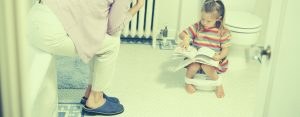
Encopresis and Constipation in Children
Encopresis and Constipation in Children Soiling, stool soiling, or fecal soiling refers to the leakage of stool that a child cannot control. This condition happens
So, you have started toilet training your two and a half-year-old, and things seem to be fine: Your toddler has become an expert in controlling their bladder and asks to use the bathroom when they need to pee. They have stopped wearing diapers and started wearing underpants instead. However, there is one problem—your child doesn’t want to poop in the toilet, but rather asks for a diaper whenever they feel the need to do the deed! Sound familiar? This is called toilet anxiety.
Let’s face it, toilet training in itself is a difficult experience for any child. But when combined with anxiety or fear of using the toilet, the process becomes even more difficult for everyone involved.
Kids with toilet anxiety can be divided into two groups:
Kids belonging to Group A tend to be anxious about pooping in the toilet bowl, but they are able to choose a different way of defecation (like asking for a diaper), and they have full bowel movements. On the other hand, kids in Group B tend to have anxiety about pooping in general, which is almost always triggered by their parents’ reaction to toilet anxiety. This leads to intentional withholding and painful defecation.
Understanding Toilet Anxiety
Careful analysis reveals that the underlying problem for both Group A and Group B is powerful anxiety. In most cases, the problem is triggered by an incident that happened during the early stages of toilet training, such as an adult humiliating the child for a poop accident in their clothes or the child suffering severe constipation, etc. This powerful toilet anxiety is the main reason, if not the only reason, for kids’ refusing to poop in the toilet—regardless of whether parents can recall an incident that led to the development of the problem.
Because of this, all the attempts you make to change your child’s behavior will ultimately be unsuccessful. Offering rewards, encouraging them to try different techniques, showing them videos, reading to them … No matter what you try, it won’t work, because the problem is not knowledge or motivation but anxiety—powerful anxiety.
Recognizing the Symptoms
With profound anxiety, pooping in the toilet becomes a disaster in the child’s mind, and they will do everything they possibly can to avoid it. Since children are intelligent and know where and where not to poop, they avoid pooping in their underpants or other inappropriate places; however, since anxiety is preventing them from using the toilet, they choose the option they feel most comfortable with—asking for a diaper. When you, as the parent, understand their situation and allow them to use the diaper whenever needed, the child feels fine continuing this method and avoids constipation.
Unfortunately, not all parents are understanding of this issue, and they continue to follow the same techniques, like using rewards, lecturing, showing videos, etc. to encourage use of the potty. Some parents, not aware of the consequences, try telling their child that they have run out of diapers, hoping that the child will then start using the toilet. Instead, the child avoids pooping and thereby develops constipation, which can get severe and serious over time.
Treating Toilet Anxiety
Dr. Kushnir’s treatment for toilet anxiety focuses on eliminating the child’s anxiety. And when it comes to toilet anxiety, it is not just the kids who need to be treated, but also their parents; after all, it is the parents who can make a significant change in their children’s feelings and habits. First, parents need to understand that their own attitudes can either create or eliminate toilet anxiety in their kids. When parents gain an understanding of the issue and act accordingly, the following therapeutic approach will work wonders for kids.
The correct process for eradicating profound toilet anxiety starts with making it okay for the child to poop anywhere and anytime they feel the need to. Next, find easy and effective ways to create an experience that is as close to pooping in the toilet as possible (without triggering anxiety, of course)!
Treatment unfolds in several tiny steps, and it can take anywhere from three weeks to several months for a child to become confident in their pooping habits and start using the toilet bowl exclusively without any anxiety. As always, progress differs from one child to another, but you will notice major improvements in your child’s psychological condition, as well as significantly reduced instances of withholding feces, right from the early phases of the therapeutic process. With gradual progress, your child will be pooping freely and confidently on the toilet by the end of treatment, without any signs of anxiety.

Encopresis and Constipation in Children Soiling, stool soiling, or fecal soiling refers to the leakage of stool that a child cannot control. This condition happens

Frequent Soiling: Causes and Treatment Frequent soiling, fecal incontinence, or encopresis is a condition when a child, typically between 5 and 9 years of age,

Toddler afraid to poop in the toilet? It could be Toilet Anxiety So, you have started toilet training your two and a half-year-old, and things

Speed up the process of progressing from infant diapers to toilet chairs or toilet seats with The Magic Bowl App.

The Magic Bowl – potty training made easy Dr. Baruch Kushnir turns potty training into a fun, effective, and most importantly, short experience. Order Now

Encopresis – you can beat it! Game-changing solutions for Toilet Anxiety, Soiling, and Constipation in Children Order Now About the book How to eliminate poop